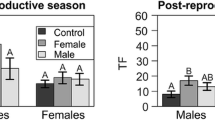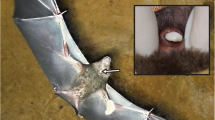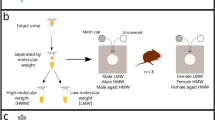Abstract
Olfaction plays an important role in the social communication of all prosimians. (The experiment reported in this paper forms part of an intensive chemobehavioral study of olfaction in Lemur catta (ring-tailed lemur) being carried out in this laboratory.) Five male Lemur cattawere tested on their behavioral responses to paired scent stimuli. Responses measured were (1) total investigation time, (2) arm-marking, (3) ABO/BO rubbing, and (4) flehmen. Males showed a strong discrimination between the scent stimuli,giving higher levels of response to female scent on measures 1, 3, and 4. This response suggests an olfactory-related preference by males for female scent under controlled conditions. This preference may be a consequence of the females’ dominance over males and the brevity of estrus in L. catta,both of which would favor such choice behavior.
Similar content being viewed by others
References
Affolter, M. (1938). Les organes cutanés brachiauxd’Hapalemur griseus. Bull. Acad. Malagache 20: 77–100.
Altieri, R., and Muller-Schwarze, D. (1980). Seasonal changes in flehmen to constant urine stimuli.J. Chem. Ecol. 6(5): 905–909.
Bailey, K. (1978). Flehmen in the ring-tailed lemur (Lemur catta).Behaviour 65(3-4): 309–319.
Bailey, K. (1979). Differential responses of ring-tailed lemurs (Lemur catta) to olfactory stimuli from conspecifics, Unpublished doctoral dissertation. Glasgow College of Technology/CNAA, Glasgow.
Budnitz, N., and Dainis, K. (1975).Lemur catta: Ecology and behavior. In Tattersall, I., and Sussman, R. W. (eds.),Lemur Biology, Plenum, New York, pp. 219–235.
Clark, A. B. (1975). Olfactory communication by scent marking in a prosimian primate,Galago crassicaudatus. Unpublished doctoral dissertation. University of Chicago, Chicago.
Doyle, G. A. (1974). Behavior of Prosimians. In Schrier, A. M., and Stollnitz, F. (eds.),Behavior of Nonhuman Primates, Academic Press, New York, pp. 155–353.
Epple, G. (1970). Quantitative studies on scent marking in the marmoset (Callithrix jacchus).Folia primatol. 13: 48–62.
Epple, G. (1971). Discrimination of the odour of males and females by the marmosetSaguinus fuscicollis spp. Proc. 3rd Int. Cong. Primatol. 1970, 3: 166–171.
Evans, C. S., and Goy, R. W. (1968). Social behaviour and reproductive cycles in captive ring-tailed lemurs (Lemur catta).J. Zool. (Lond.) 156: 181–197.
Evans, C. S. (1983). On the structure and function of accessory chemoreceptive organs. In Paneliur, S. (ed.), Proc. III Int. Theriol. Cong.Acta Zool. Fenn. (Suppl.) (in press).
Harrington, J. E. (1976). Discrimination between individuals by scent inLemur fulvus. Anim. Behav. 24: 207–212.
Harrington, J. E. (1977). Discrimination between males and females by scent inLemur fulvus. Anim. Behav. 25: 147–151.
Hunter, A. J. (1981). Chemical communication, aggression and sexual behaviour in the owl monkey (Aotus trivirgatus). Unpublished doctoral dissertation. University of London, London.
Jolly, A. (1966).Lemur Behavior, University of Chicago Press, Chicago.
Mertl, A. S. (1977). Habituation to territoral scent marks in the field byLemur catta. Behav. Biol. 21: 500–507.
Petter, J.-J., and Peyrieras, A. (1970). Observations éco-éthologiques sur les lémuriens Malagaches du genreHapalemur. Terre Vie 24: 356–382.
Pollock, J. I. (1979). Female dominance inIndri indri. Folia primatol 31: 143–164.
Schilling, A. (1974). A study of marking behavior inLemur catta. In Martin, R. D., Doyle, G.A., and Walker, A. C. (eds.),Prosimian Biology, Duckworth, London, pp. 347–362.
Schneider, K. M. (1930). Das Flehmen I.Der Zool. Garten 3: 183–198.
Seitz, E. (1969). Die Bedeutung geruchlicher Orientierung beim Plumplori,Nycticebus coucang. Z. Tierpsychol. 26: 73–103.
Wysocki, C. J. (1979). Neurobehavioural evidence for the involvement of the vomeronasal system in mammalian reproduction.Neurosci. Biochem. Rev. 3(4): 301–341.
Author information
Authors and Affiliations
Rights and permissions
About this article
Cite this article
Dugmore, S.J., Bailey, K. & Evans, C.S. Discrimination by male ring-tailed Lemurs (Lemur catta) between the scent marks of male and those of female conspecifics. Int J Primatol 5, 235–245 (1984). https://doi.org/10.1007/BF02735759
Received:
Revised:
Issue Date:
DOI: https://doi.org/10.1007/BF02735759




